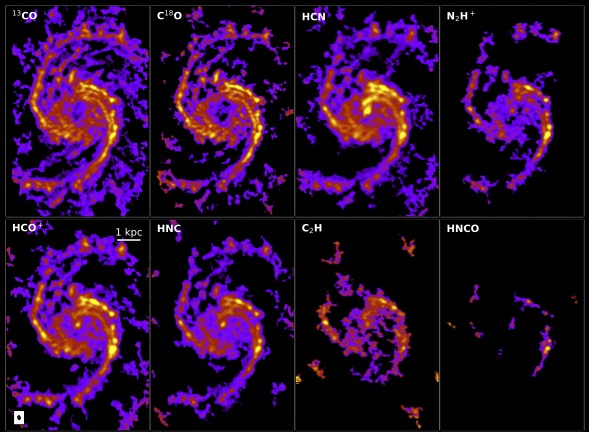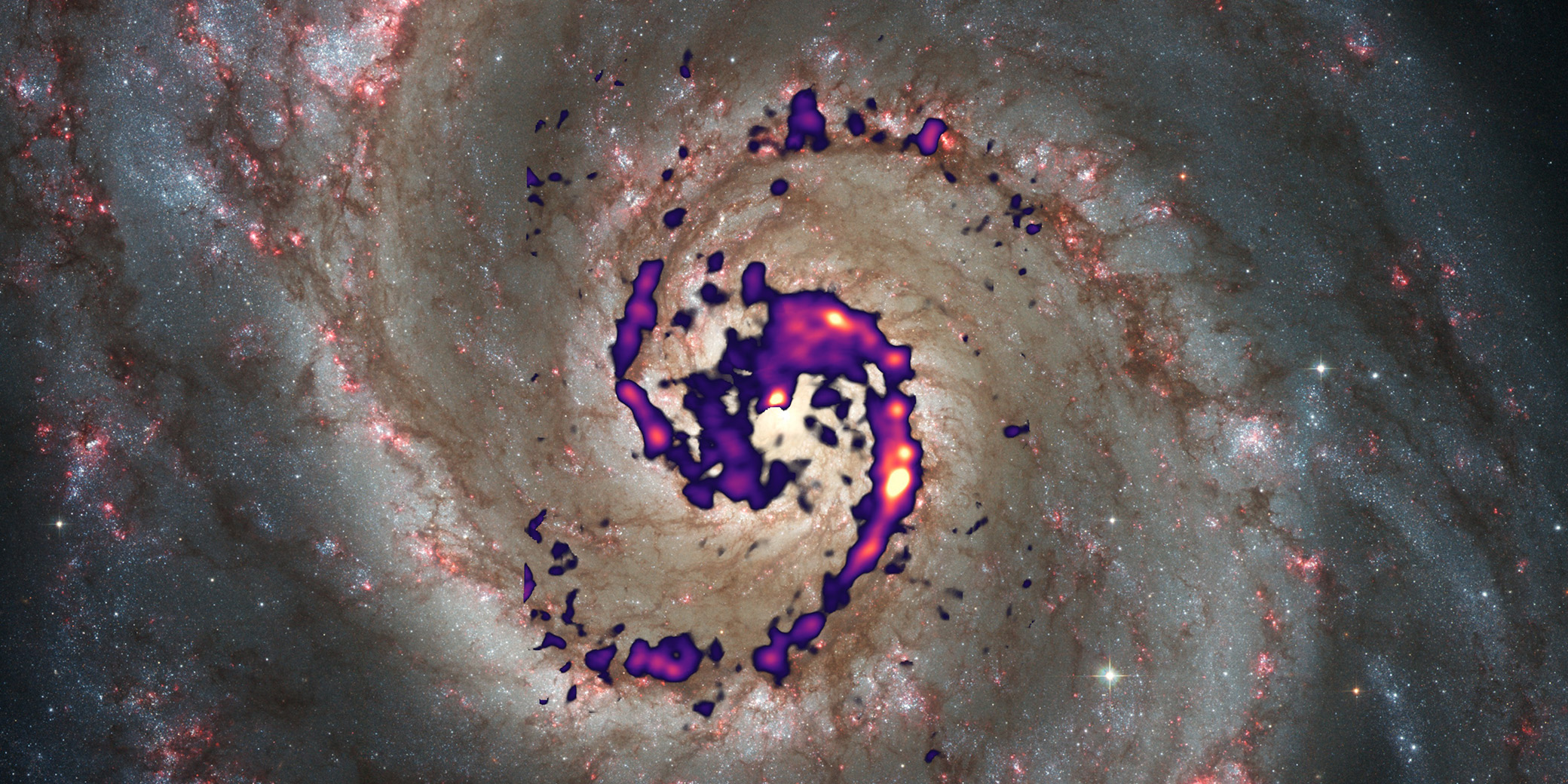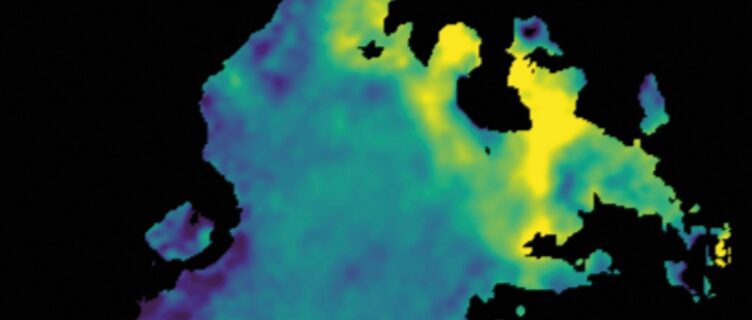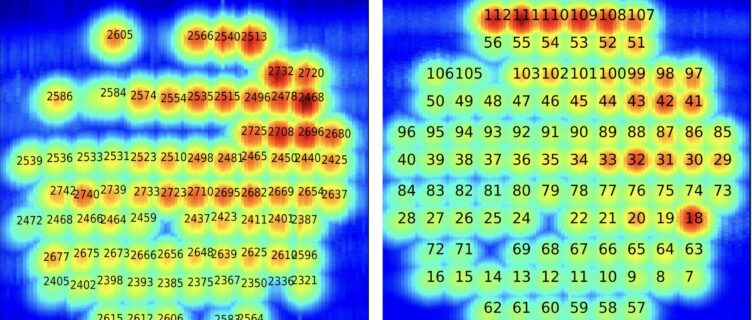An international research team led by the Max Planck Institute for Astronomy (MPIA) has mapped large regions of cold and dense gas – the birthplaces of future stars – with unprecedented detail in a galaxy beyond the Milky Way. Utilizing the NOEMA observatory, these observations provide insight into varying conditions conducive to star formation. The data marks a ground-breaking achievement in this type of measurement, allowing researchers, for the first time, to scrutinize the early phases of star formation beyond our own Milky Way at the scale of individual gas clouds, and thus better inform the models of star formation used to explain the evolution of galaxy throughout the history of the universe.
Paradoxically, the fate of hot stars initiates in some of the coldest realms of the universe – dense clouds of gas and dust that traverse entire galaxies. “To investigate the early phases of star formation, where gas gradually condenses to eventually produce stars, we must first identify these regions,” says Sophia Stuber, a PhD student at the Max Planck Institute for Astronomy (MPIA) in Heidelberg. She is the lead author of the research article in Astronomy & Astrophysics. “For this purpose, we typically measure the radiation emitted by specific molecules that are particularly abundant in these extremely cold and dense zones.”
Molecules as chemical probes
Astronomers typically employ molecules such as hydrogen cyanide (HCN) and diazenylium (N2H+) as chemical probes in exploring star formation within the Milky Way. “But only now have we been able to measure these signatures in great detail over a large fraction of a galaxy located roughly 28 million light-years from Earth, covering various zones with diverse conditions,” explains Eva Schinnerer, research group leader at MPIA. “Even at first glance, it’s evident that while the two molecules effectively reveal dense gas, they also disclose interesting differences.”
Through collisions with the elusive yet much more abundant hydrogen molecules, other molecules are set into rotation. As these molecules slow down in rotational speed, they emit radiation with characteristic wavelengths, around three millimeters for the above-mentioned molecules.
These measurements are part of a comprehensive observational program named SWAN (Surveying the Whirlpool at Arcsecond with NOEMA), co-led by Eva Schinnerer and Frank Bigiel from the University of Bonn. Utilizing the advanced capabilities of the NOEMA observatory and complemented by observations from the IRAM 30-meter telescope, the international team investigates the spatial distribution of various molecules within the inner 20,000 light-years of the Whirlpool Galaxy (Messier 51), focusing on molecular compounds such as hydrogen cyanide and diazenylium.
Until recently, radio observatories like NOEMA could only trace the signal of one molecule at a time. Observing the emissions of a large set of molecules within a cosmic source was both, time-consuming and expensive. With the advent of new broad band receiver systems and spectrometers powered by recent electronic progress, IRAM observatories can now observe many such tracers in a single observing run. “This is a game changer”, says co-author Jérôme Pety.

The whirlpool galaxy viewed in many different tracers (including HCN and N2H+) observed simultaneously by NOEMA. The variations of emission in the different tracers in each pixel informs astronomers about the local conditions at play in the formation of stars. Credits: IRAM.
Gas properties depend on the environment
The authors of the study were able to distinguish signatures of individual gas clouds in diverse areas, such as the centre and the spiral arms. “We leveraged the proximity of M51 to determine how well the two gases trace the dense clouds in this galaxy for us and whether they are equally suited,” Stuber explains.
While the radiation intensity of hydrogen cyanide and diazenylium consistently increases and decreases across the spiral arms, providing equally reliable results for determining gas densities, the astronomers find a notable deviation in the galactic centre of M51. Compared to diazenylium, the brightness of hydrogen cyanide emission increases more significantly in this region. There appears to be a mechanism there that stimulates hydrogen cyanide to emit additional light, which is not observed in diazenylium.
“We suspect that the active galactic nucleus in the Whirlpool Galaxy is responsible for this,” Schinnerer says. Surrounding the central massive black hole at its center, this region is where the gas swirls around the black hole in the form of a rotating disk. As it spirals down, the gas accelerates to high velocities and is heated by friction to thousands of degrees, emitting intense radiation which contributes to the emission of hydrogen cyanide molecules. “However, we still need to explore in detail what makes the two gases behave differently,” Schinnerer adds.
Hence, at least in the central region of the Whirlpool Galaxy, diazenylium appears to be the more reliable density probe compared to hydrogen cyanide. This is important because hydrogen cyanide is routinely used to determine the mass of gas that will form the future generation of massive stars in the early days of the universe. This result means that the amount of available gas for star formation might be larger than expected based on the luminosity of the hydrogen cyanide.
A worthwhile challenge
Getting to explore the early phases of star formation in nearby galaxies is a unique opportunity for scientists. While molecular clouds and star-forming regions within the Milky Way are closer to Earth, our planet’s position ‘right in the middle’ makes it difficult to observe our galaxy’s large scale structures such as the spiral arms or the central black hole and their efficiency of star formation. In contrast, observing nearby galaxies from the Milky Way allows astronomers to distinguish between these structures.
“Although we can learn a lot from the detailed observation program with the Whirlpool Galaxy, it is, in a sense, a pilot project,” Stuber points out. “We would love to explore more galaxies in this way in the future.” However, this possibility currently faces limitations due to technical capabilities. The Whirlpool Galaxy shines exceptionally brightly in the light of those chemical probes. “In the quest to investigate more distant galaxies, the future hinges on developing telescopes and instruments with unprecedented sensitivity. Until then, the Whirlpool Galaxy will serve as a rich laboratory to explore star formation on a galactic scale.” concludes Jérôme Pety.
More information
Surveying the Whirlpool at Arcseconds with NOEMA (SWAN)- I. Mapping the HCN and N2H+ 3mm lines, Sophia K. Stuber, Jerome Pety, Eva Schinnerer et al., Astronomy & Astrophysics Letters (2023).
Science contacts
Sophia K. Stuber, Max Planck Institute for Astronomy, Heidelberg, Phone: +49 6221 528-351, Mail: stuber@mpia.de
Our latest updates
Explore all the latest news from our research and technology groups and never miss out on important upcoming events.














